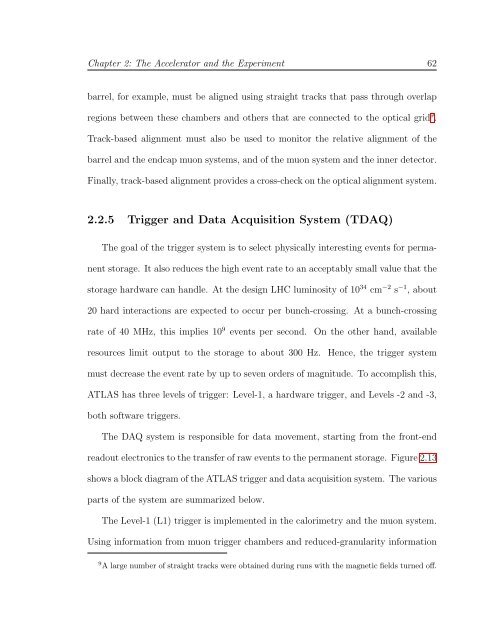Measurement of the Z boson cross-section in - Harvard University ...
Measurement of the Z boson cross-section in - Harvard University ...
Measurement of the Z boson cross-section in - Harvard University ...
You also want an ePaper? Increase the reach of your titles
YUMPU automatically turns print PDFs into web optimized ePapers that Google loves.
Chapter 2: The Accelerator and <strong>the</strong> Experiment 62<br />
barrel, for example, must be aligned us<strong>in</strong>g straight tracks that pass through overlap<br />
regions between <strong>the</strong>se chambers and o<strong>the</strong>rs that are connected to <strong>the</strong> optical grid 9 .<br />
Track-based alignment must also be used to monitor <strong>the</strong> relative alignment <strong>of</strong> <strong>the</strong><br />
barrel and <strong>the</strong> endcap muon systems, and <strong>of</strong> <strong>the</strong> muon system and <strong>the</strong> <strong>in</strong>ner detector.<br />
F<strong>in</strong>ally, track-based alignment provides a <strong>cross</strong>-check on <strong>the</strong> optical alignment system.<br />
2.2.5 Trigger and Data Acquisition System (TDAQ)<br />
The goal <strong>of</strong> <strong>the</strong> trigger system is to select physically <strong>in</strong>terest<strong>in</strong>g events for perma-<br />
nent storage. It also reduces <strong>the</strong> high event rate to an acceptably small value that <strong>the</strong><br />
storage hardware can handle. At <strong>the</strong> design LHC lum<strong>in</strong>osity <strong>of</strong> 10 34 cm −2 s −1 , about<br />
20 hard <strong>in</strong>teractions are expected to occur per bunch-<strong>cross</strong><strong>in</strong>g. At a bunch-<strong>cross</strong><strong>in</strong>g<br />
rate <strong>of</strong> 40 MHz, this implies 10 9 events per second. On <strong>the</strong> o<strong>the</strong>r hand, available<br />
resources limit output to <strong>the</strong> storage to about 300 Hz. Hence, <strong>the</strong> trigger system<br />
must decrease <strong>the</strong> event rate by up to seven orders <strong>of</strong> magnitude. To accomplish this,<br />
ATLAS has three levels <strong>of</strong> trigger: Level-1, a hardware trigger, and Levels -2 and -3,<br />
both s<strong>of</strong>tware triggers.<br />
The DAQ system is responsible for data movement, start<strong>in</strong>g from <strong>the</strong> front-end<br />
readout electronics to <strong>the</strong> transfer <strong>of</strong> raw events to <strong>the</strong> permanent storage. Figure 2.13<br />
shows a block diagram <strong>of</strong> <strong>the</strong> ATLAS trigger and data acquisition system. The various<br />
parts <strong>of</strong> <strong>the</strong> system are summarized below.<br />
The Level-1 (L1) trigger is implemented <strong>in</strong> <strong>the</strong> calorimetry and <strong>the</strong> muon system.<br />
Us<strong>in</strong>g <strong>in</strong>formation from muon trigger chambers and reduced-granularity <strong>in</strong>formation<br />
9 A large number <strong>of</strong> straight tracks were obta<strong>in</strong>ed dur<strong>in</strong>g runs with <strong>the</strong> magnetic fields turned <strong>of</strong>f.















